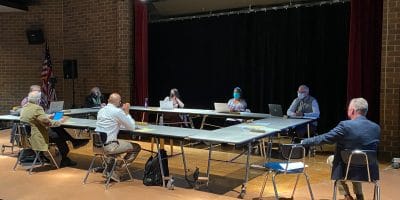
By Lars Åkerson, contributor
Even as hospitals overflow with record numbers of Covid-19 patients in other parts of the country and world, the Central Shenandoah Health District is upbeat about the progress of the state health department’s vaccination campaign in their jurisdiction.
The Virginia Department of Health has set a goal of vaccinating at least three quarters of the state’s population. Twenty weeks since the first vaccine received FDA authorization, the area health district reports that 76% of those over the age of 65 have received their first shot.
Vaccination rates among younger age groups lag far below this threshold. One in five vaccine-eligible residents of Harrisonburg and Rockingham County under the age of 50 have been fully vaccinated, in part due to the shorter time these demographics have been broadly eligible for vaccination.
Though anyone 16 years and older may now be vaccinated, the health department is also seeing tapering vaccination rates. Public health officials identify a number of causes at play beyond either anti-vaccine ideology or mistrust of the health system. Younger populations may feel less urgency to be vaccinated due to a perception of lower health risk, and the working-age population may also face challenges getting time off work to be vaccinated or to recover from side effects. They may also lack transportation to the mass-vaccination clinics where the bulk of the shots have been delivered to date.
In response, the health district is pivoting its vaccine delivery strategy, said Population Health Coordinator Laura Lee Wight. Rather than requiring pre-registration, vaccination clinics are now receiving walk-ups.
This change, made possible by lower general demand, comes at the recommendation of VDH community partners. They identified registration as a barrier to vaccine access, especially for those uncomfortable speaking English or who lack reliable internet access. Even so, the health department still encourages people to register online or by phone prior to arrival in order to ensure availability and avoid longer wait times.
The VDH also plans to shift from mass-vaccination sites toward reaching the unvaccinated through mobile, community-based vaccine drives. These smaller, pop-up events will be coordinated and advertised in collaboration with local employers and community groups, including churches, according to Wight.
Targets for these mobile clinics will be more modest—“10, 20, 100 people vaccinated, that’s a win for the community,” said Wight—but they will help the department address barriers to access posed by a lack of transportation or inflexible work schedules. The goal is to reach people where they “work, pray, and play,” the district’s population health coordinator added.
Domestic vaccinations have been a top national priority. 100 days into the new administration’s tenure, more than 230 million doses have been administered across the United States. The state health department reports more than 6 million shots given in Virginia.
Thirty percent of the state is fully vaccinated, on par with national rates. In Harrisonburg and Rockingham County, that figure is about 25 percent.
The Biden administration has called for all employers to provide their staff with paid leave for vaccination and recovery from the vaccines’ side effects. The IRS will offer businesses and nonprofits with fewer than 500 employees a tax credit to help defray the costs of what national leaders have called a civic duty.
It is up to individual employers to act upon this appeal to incentivize workers’ vaccination. If employers are not proactive in offering the benefit, Virginia’s at-will employment regime increases the vulnerability of wage workers and those without legal status in the country who might need time off.
The VDH is working to reduce all barriers to vaccination. “The health department is committed to making sure our vaccine outreach is being conducted through a lens of health equity,” said Wight. State data indicates that Latinx city and county residents tend not to complete vaccination at higher rates than their white and Black neighbors.
Wight says the health district is leveraging an evidence- and partnership-based approach to increase vaccine access and uptake.
“There’s obviously a ways to go,” she says, but the department is optimistic looking at the data and their growing network of community partners. Brought together, they guide campaign strategy by asking and answering better questions: “where are our traditionally-underserved communities, what do the social determinants of health tell us about access for those communities, and how do we engage with them, listen to what they need, and present the vaccine on their terms.”
Journalism is changing, and that’s why The Citizen is here. We’re independent. We’re local. We pay our contributors, and the money you give goes directly to the reporting. No overhead. No printing costs. Just facts, stories and context. We’re also a proud member of the Virginia Press Association. Thanks for your support.












